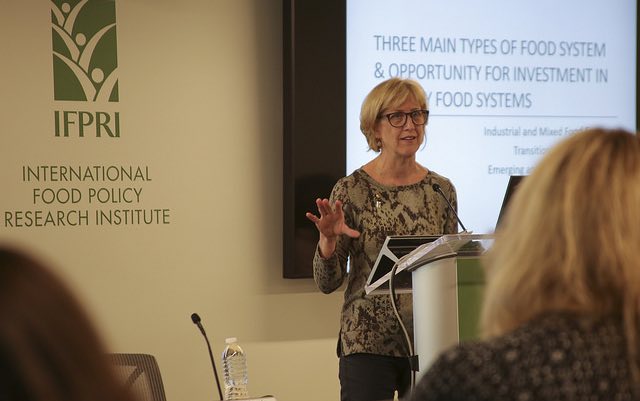“Every country in the world has a problem with malnutrition, and 88 percent of the countries face this burden in either two or three forms,” Marie Ruel, director of IFPRI’s Poverty, Health and Nutrition Division, told a recent policy seminar, Investment for Nutrition. “We are running out of time.”
Stineke Oenema, coordinator of the UN System Standing Committee on Nutrition (UNSCN), which co-sponsored the event, joined Ruel and David Laborde of IFPRI, Rachel Nugent of RTI International, and Preeti Ahuja of the World Bank to discuss options on how investments in food systems and agriculture can be best tailored to improve nutrition. The IFPRI-UNSCN seminar followed up on an Oct. 2017 side event on this topic at the 44th session of the Committee on World Food Security (CFS).
UNSCN works to “maximize policy coherence” for nutrition, providing a neutral platform to discuss new and emerging issues that have an impact on nutrition, seeking debate when there is no policy consensus, Oenema said. However, it is essential to shift the focus from policy makers in Rome to investors. Investments are often divorced from nutrition policies and programs—agricultural and food investment policies aim to increase economic rates of return, not the quality of what is produced, she said.
In particular, better data are needed to identify sound investments for nutrition and healthy food systems, Oenema said. While the Nutrition Decade provides “a complete agenda” for improving food systems, she noted, the policies to guide investments are not there yet.
Ending hunger generates economic benefits both in the short and long term, Laborde explained. Lowering undernutrition to 5 percent or less in every country by 2030, for example, would raise productivity and boost global GDP by $276 billion. But estimates also vary widely on the amount of investment required to end hunger and undernutrition, he explained.
Meanwhile, overweight and obesity are on the rise, along with associated diet-related diseases, Nugent said—trends that “are all directly tied to investment decisions made decades ago.” These too require sustained investments, she said, reminding participants that solutions to support healthier food systems are easily accessible for countries in the Framework for Action from the Second International Conference on Nutrition (ICN2) in 2014. Examples of promising interventions include marketing regulations, school nutrition programs that target differential malnutrition risks in children, and the reformulation of food products to with nutritious and sustainable guidelines. But significant knowledge gaps remain on the impacts of such programs, Nugent said, encouraging financial institutions and development banks to provide contextualized financial information to better identify promising investments.
Ahuja explained the World Bank’s approach to nutrition investment, including: Identifying and scaling up impactful and cost effective nutrition interventions; stemming post-harvest loss and waste of nutritious foods; reorienting public investments (e.g. subsidies, R&D) and private incentives to promote supply of nutritious foods; and finally, engaging and partnering with the public and private sector.
The World Bank embraces nutrition efforts across all sectors, Ahuja said. It screens every project for opportunities to enhance nutrition outcomes, and is increasing the number of projects with an explicit nutrition-specific focus. A total investment of $70 billion is needed during the Nutrition Decade to meet World Health Assembly nutrition targets, the World Bank estimates.
If research and policy could be better linked, such investments should be more effective, the panelists agreed. For instance, it matters what type of food is produced, and currently most government subsidies do not support production of nutritious foods such as fruits and vegetables, but rather go to traditional commodities such as grains.
In response to a question from the audience asking how members of civil society can help, Oenema suggested that organizations working on food systems join the UNSCN online communities of practice.
The policy seminar closed with a clear message: Investments must shift from the current focus on high-volume production of a small number of crops to increased quality and diversity of food production for healthy diets. Existing knowledge, infrastructure, and investments should be leveraged to close the nutrition financing gap and countries need to invest more than the current rate of 1 percent of development assistance funds.
Tea Franich and Christine Campeau are consultants with UN System Standing Committee on Nutrition Secretariat.







